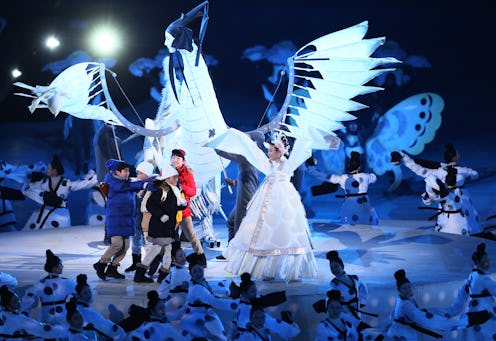News
The Meaning Behind The Opening Ceremony’s First Scene Was So Symbolic

The 2018 PyeongChang Winter Olympics officially began with a celebratory and symbolic opening ceremony. And the meaning of the first scene of the Olympic opening ceremony captured the spirit of wonder and hope often associated with the games, as five children followed Soohorang the White Tiger, a traditional South Korean guardian god and this year's Olympic mascot.
According to the official 2018 PyeongChang Olympics website, the white tiger has traditionally been seen as "Korea’s guardian animal." In Korean, the word "Sooho" translates as "protection," and Soohorang symbolizes protection extended to all athletic competitors, participants, and spectators at the games in South Korea.
The first segment of the opening ceremonies was given the name "The Countdown." As the five children followed Soohorang, they traveled through time, seeking peace. They first met Soohorang "at an ancient field of snow where heaven, earth, and nature are in communion with people," according to The Guardian. Then the segment ended with a holographic display of Cheonsang Yeolcha Bunyajido, a South Korean chart of the constellations and stars, projected as an illuminated dome over the ceremony's circular main stage.
The organizers of the event said they chose to use five children to correspond with the five Olympic rings, and each of the character the children represented were given names that encompass the "Five Elements — fire, water, wood, metal, and earth — which are believed to make up the universe."
The theme of the opening ceremony was peace and harmony, a message that extended throughout the festivities in PyeongChang. Following the first "Countdown" installment came the second segment, entitled "The Land of Peace." Full of symbolism, "The Land of Peace" incorporated the use of light movement on the stage floor to create a yin and yang, also known in Korean as the "taegeuk." The symbol is found in the center of South Korea's flag, with the top read comma shape representing the "forces of yang," and the bottom blue the "forces of yin."
After forming the taegeuk, the lights moved to create the four trigrams featured on South Korea's flag, which symbolize the four elements of heaven, earth, water, and fire. The trigrams are also representative of the four seasons and the four directions, north, south, east, and west.
The next segment in the children's journey was "Taeguk: Harmony of the Cosmos." The five kids rode a boat across a stage designed to look like a green field. They were trailed by the River of Time, which symbolized the upheaval and struggle of South Korea's past. Carrying the Taegukgi flag of South Korea, eight former Olympians eventually took center stage, followed by the singing of their national anthem by a children's choir.
After the athlete delegations from all competing countries entered the stadium, the artistic performances picked back up again. In "All for the Future," the five children from the original three segments have now grown up and emerge as adults leading the technology and information fields. South Korea presents a decidedly hopeful view of the future, as people are completely connected — to one another, to objects, to time, to space.
The final artistic portion of the night was entitled "Peace In Motion." The five children raised a candle for peace, while a group of South Korean singers performed a rendition of "Imagine" by John Lennon.
The program described the scene:
Candlelight symbolizing hope spreads from one person to the next. When the warmth of candlelight fills the stage, everyone becomes of one heart and starts to sing. Hoping for peace, the five children release the dove in the skies above PyeongChang.
Like many of its modern predecessors, the opening Olympic ceremonies in PyeongChang, South Korea, were steeped in symbolism.